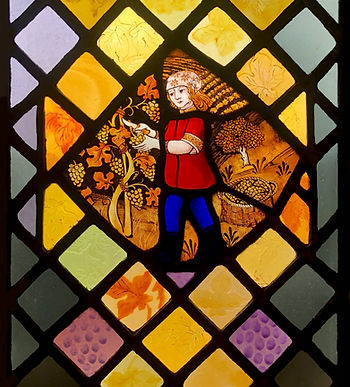Window 15: The Eucharistic Wine
The fifteenth window in the Creation and the New Creation series of windows at the church of Saints Leonard and Fergus, Dundee.
Window 15: The Eucharistic Wine is the second of a pair of windows that focus on the sacrament of the Eucharist. For this reason, it is best read after Window 14: The Eucharistic Bread to appreciate the details that relate to both.
This window is the first of five Summer windows (Window 14 was the last of the Spring ones) and it sits to the right of the altar. Here the background latticework pattern is rich with the warm yellows and golds of Summer. Like Window 14, it contains a border in various shades of blue. The border distinguishes them both from the other windows which are borderless, and highlights their importance.

The stylised grapevine, heavily laden with purple grapes, which fills the whole main window.
Comparable to the eucharistic bread window being filled from top to bottom with ears of wheat, this window is filled from top to bottom with a stylised grapevine, heavily laden with bunches of purple grapesgrapes being the ingredient of the eucharistic wine. Also comparable, the grapevine is mainly acid-etched, the shimmer and movement of this technique conveying a sense of mystery and awe inspired by the sacrament of the Eucharist. The leaves of the grapevine form a rich, golden Celtic latticework pattern, and the purple grapes stand out in contrast in the spaces in the pattern.
The focal point of the main window is a painted illustration of a medieval style grape-picker, cutting a bunch of grapes from a vine and putting it in her basket. This painting is based on a stained-glass roundel of a grape-picker made in c.1480 in Norwich, and currently held in the Victoria and Albert museum. The figure in the original medieval roundel is male, but Dad modified it to make it female, with a handkerchief-type scarf on her head, like the sort Mom used to wear when we were children, and he changed the background somewhat.
The grape-picker is picking grapes to ferment and turn into the eucharistic wine, or communion wine. Eucharistic wine is usually red, to better symbolise the change from wine into the blood of Christ and here, Dad changed his medieval source to make the grapes purple rather than green, as it is purple grapes that make red wine. Just as the inclusion of a traditional baker in the eucharistic bread window emphasises the human involvement in the consecration of the bread, so the grape-picker in this window emphasises the human involvement in
When the wine is elevated during the Offertory prayers, the priest says, ‘…through your goodness we have received the wine we offer you: fruit of the vine and work of human hands, it will become our spiritual drink’. A moment’s reflection reveals just

Window 15: The Eucharistic Wine.

The grape-picker.
how much ‘work of human hands’ is involved in the process of growing, harvesting and processing the wheat and grapes that become the communion host and wine.

In the transom of this window is a depiction of the most sacred object, the chalice, which holds the eucharistic wine. When designing this window and looking for sources, Dad looked for the most ornate chalice he could find to best represent the precious blood of Christ. The best fit was the 8th century Tassilo Chalice, a very ornate Anglo-Saxon design, made of bronze and gilded with silver and gold and normally kept in Kremsmünster, in upper Austria. Around the cup are five oval medallions showing Christ and the four evangelists; Dad painted it with Christ at the front. He created a beautiful connection between the wine grapes in the main window and the chalice by using the colour purple in both, to indicate the continuity between the wine grapes and the blood of Christ.
Around the base are icons of John the Baptist and Mary (and another figure at the back). On the Tassilo Chalice they both look rather severe but Dad gave them sunnier expressions, which are rather more uplifting and appropriate for this most joyful sacrament.
The chalice in the transom, based on the 8th century Tassilo Chalice.
the consecration of the wine. That Dad changed the grape-picker from male to female has symbolic importance in that the female grape-picker, taken alongside the male baker in the previous window, includes both sexes in the ‘work of human hands’ of the eucharistic liturgy.
